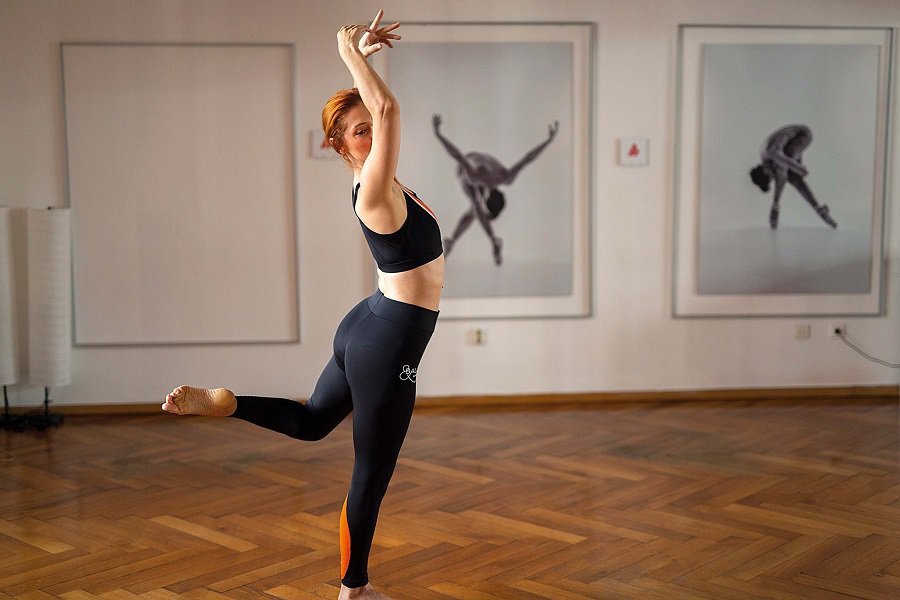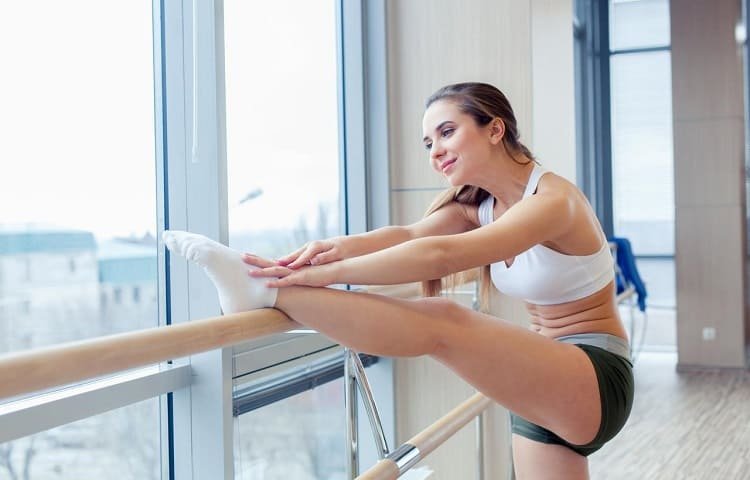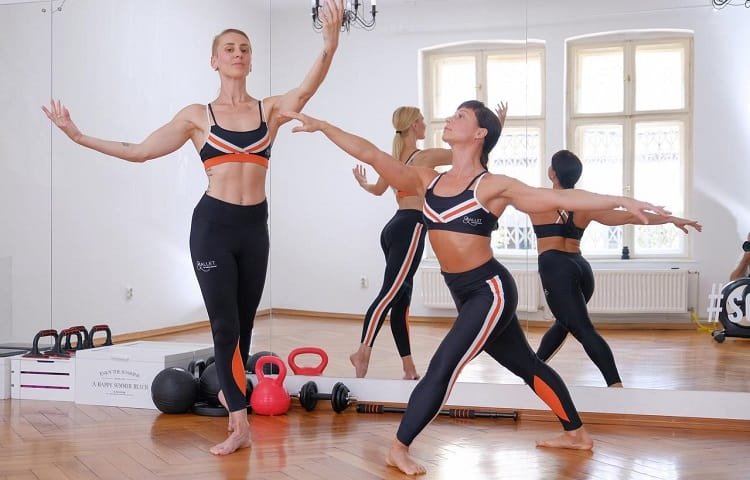 Ballet is a beautiful art form.
Ballet is a beautiful art form.
It is also a great workout that has many positive benefits for your health and physique.
But it is also a grueling art form.
Dancers suffer from constant annoying injuries.
And in the long term, ballet can have some serious consequences on your body.
Keep reading to learn what long term effects ballet can have on the body, some common everyday ailments ballerinas suffer from, and some tips on preventing some of the common injuries.
We’ll finish up with some good news: a rundown of some of the positive effects ballet can have on your body.
Table of Contents
Long Term Effects Of Ballet On The Body
Ballet dancers need to be careful with the amount of practice they tend to do and the pressure they put on the body. Ballet can cause severe long-term damage.
These are injuries that can stay with you for the rest of your life. Many occur in old age as a result of the extreme stress ballet put on the body over many years.
The issues listed below generally only affect professional ballet performers because of their rigorous lifestyle, grueling practice sessions, and their need to stay on pointe for an extended time.
Arthrosis

The American Journal of Sports Medicine found a statistically significant increase in arthrosis of the ankle and the subtalar and metatarsophalangeal joints in people who have practiced ballet throughout their lives, than people who have never practiced ballet.
The main reason behind this long-term damage is repetitive microtrauma. This type of arthritis occurs when the most crucial protective layer of tissue depletes and wears down.
Dancing long term means a continuous wearing down of the flexible tissues at the end of the bones. This condition worsens over time.
Sesamoiditis
Sesamoids are bones, but they are different from other bones in the body. Most bones connect to each other via joints, but sesamoids are connected to muscles via tendons.
The largest sesamoid we have is our kneecap, but we are mostly concerned with two smaller ones located on the bottom of our feet, near our big toes.
When the tendons connecting these sesamoids become inflamed, the resulting condition is called sesamoiditis. This usually happens due to strain or overworking of the tendons.
Sesamoiditis can be quite painful, but you can treat it with rest and anti-inflammatory medications. If left untreated and if you continue to practice through the pain (as is very common in professional ballet), this can lead to serious long-term damage to your foot.
Ulcers

Foot corns are common for dancers. They are hardened layers of skin that develop from repeated friction and pressure.
If you continue to practice, without allowing the corns to heal, they can start pressing into your foot. This destroys the inner layers of fat and skin and can give rise to sores and ulcers.
These sores and ulcers can become infected, and the infection can quickly spread to the bone, if not treated. If this happens, you will likely need to have your foot amputated.
Heel Spurs
The constant wear and tear on your feet can give rise to another serious health condition called heel spurs. These heel spurs do not grow overnight, but over the course of several years.
They begin as a small bony growth around the heel bone. It happens inside your foot, so you probably won’t even notice it at first.
As it grows, it can change the shape of the feet and sometimes cause pain while walking or standing for an extended period. Once it becomes big, it causes severe issues while walking (and, of course, dancing).
Hammertoes
A hammertoe is yet another long-term injury common in ballerinas. It is is caused by wearing the pointe shoes.

These shoes restrict the toes from keeping their shape and cause an abnormal bend in the middle joints of the fours smaller toes.
It is easy to notice, because the bone usually protrudes and looks out of place. You can treat it fairly easily, but since ballerinas are required to wear pointe shoes all the time, they do not always give this condition the time to heal. As a result, it can worsen, and might eventually require surgery.
Cancer
It is a known fact that many models and ballerinas take up smoking cigarettes to stay thin. They also tend to restrict their food intake. The combination of smoking cigarettes and a lack of healthy nutrients can have a severe effect on overall health.
Eventually, it can lead to mouth and lung cancer. Any good trainer will encourage their dancers to eat sufficient food and to refrain from smoking, but many actually encourage ballerinas to starve themselves and to smoke, in order to maintain a thin figure. If you trainer does this, report him or her and find a new one.
Severe Bruised Thick Toenails
Damage to toenails is a daily occurrence and the constant practice doesn’t give you enough time to let them heal.
Over the years, the nails turn thick and dark. They can also become ingrown and you can get hard skin underneath them. Many ballerinas do not feel comfortable roaming around in open-toed shoes, because of their unsightly toenails. This is another injury that stays with you for a long time.
Eating Disorders
We already touched on this a bit above. To stay in prim and proper shape, many ballerinas will start eating less. Often, this begins in childhood.
This puts them at risk of developing serious eating disorders like bulimia, anorexia, which lead to serious malnutrition. Eating disorders have severe consequences on both mental and physical wellbeing.
Inadequate nutrition in mature and adolescent females can also put them at risk of developing scoliosis and can reduce their bone density.
While being slim is important in order to perform at your best and to have good form while dancing, you need to be sure you keep the weight off in a healthy manner. Otherwise, it will have severe long-term effects on your body.
In a recent interview Dr. Roth, a dietician specializing in medical nutrition therapy, talks about the possible adverse impact of ballet on healthy nutrition. She explains that malnutrition in young girls delays puberty and stunts their growth, causing negative effects on their overall health for the rest of their lives.
Everyday Ballet Effects On The Body

The following are some of the common effects a ballet dancer can suffer from on a day to day basis. Some of these can lead to long term problems, if not allowed to heal properly.
Damaged Nails
Ballerinas usually suffer from black and broken nails within a week of their practice because of repeated
impact. Their nails often go black because of the damage or blood accumulation.
Another common injury is ingrown toenails. These dancers face the problem of ingrown toenails when
skin starts surrounding the edge or corner of their nails. The pressure from their shoes forces the nail into the skin. Ballerinas need to take proper care of their feet to keep them healthy and damage-free.
Calluses And Blisters
Dancers can get a nasty case of blisters when they use new shoes that aren’t broken in. The friction leads to blisters and makes their feet raw. These blisters eventually turn into calluses.
Bunions
A bunion is a tiny bony bump at the base of your big toe. Bunions occur when the toes of ballerinas are squished together in their shoes, causing tension on the toe joint. This pressure forces the joint at the base of their big toe to stick out sideways.
Sprained Ankles
The feet are used for absolutely everything is ballet. It comes as no surprise that sprained ankles are often the very first injury new dancers suffer. This injury is common when dancers overwork the lateral side of the ankle.
Posterior Impingement Syndrome
Posterior impingement syndrome is commonly known as dancer’s heel or dancer’s ankle. It occurs when a bony formation at the rear of the ankle compresses the tissue. This pinching of the tissue is painful and can result in the tissue becoming inflamed.
Morton’s Neuroma
Morton’s neuroma refers to the thickening of the skin around the nerves near the toes and the ball of the foot. It can make it hard to stand erect and cause extreme, sharp burning pain–and sometimes numbness–in the ball of the foot.
Stress Fractures
These are tiny hairline fractures and cracks in the bones caused by extra pressure or overuse of the feet. These fractures can feel a lot worse when you jumps or twirl.
If you stay off your feet, you can recover from stress fractures fairly quickly. But most dancers carry on with their practices, so the stress fractures might not heal quickly, if at all. They can result in severe injuries in the future, if they are not allowed to heal..
Achilles Tendonitis
Achilles tendonitis occurs because of the overuse of the Achilles tendon. If it is a minor injury, you can quickly recover by providing basic treatment at home. If it is a severe case, it can lead to a tear in the Achilles, which might require surgery.
Plantar Fasciitis
This injury is a severe inflammation of the tissues that connect the toes to the heels. The inflamed tissues usually run across the bottom of the foot and cause extreme discomfort or pain.
Hallux Rigidus
Hallux rigidus means stiff big toe in Latin. This injury usually affects the base joint of the big toe and can make it hard to move the toe. Since the toe is squished in the pointe shoes, it can worsen the condition (and the pain) without proper medical care.
Tips To Prevent Negative Effects
Here are a few tips that can help you prevent, or at least minimize, some of the negative effects of ballet on your body.
- Make a habit of wearing toe spacers, gel pads, tape, and plasters to relieve the significant pressure points.
- Always wear supportive shoes, like a lace-up brogue or trainers, to give ample support and comfort to your feet on your non-ballet days.
- Johns Hopkins Medical Center recommends that ballet practice should not exceed five hours per day.
- Cross-training exercises can build great endurance and strength to avoid big-little injuries.
- Keep a healthy lifestyle, especially when it comes to nutrition; do not starve yourself.
- Immediately address any injuries and consult a doctor or podiatrist for any serious or lasting affliction.
Positive Long Term Effects Of Ballet
While there are significant negative long-term effects that should not be overlooked, we also want to highlight some of the positive effects.
Ballet is a wonderful art form and we do not want to discourage any budding ballerinas and ballerinos. It is also a great workout for anyone.
A good ballet barre workout routine can get anyone in shape. Here are some of the positive effects of ballet. You can see why ballet has become popular among football players and other athletes.
Flexibility

What makes you flexible?
It’s the length of your muscles (and ballet can lengthen them more) It’s the elasticity of your cartilage. It’s well-lubricated, healthy joints that allow for crazy movements.
How do you train all of those at once? Ballet.
Even if you’re just doing your ballet barre warm up every day, you’ll notice that you can stretch farther the more you do them.
Five to fifteen minutes of stretching alone can greatly benefit you, but when a ballerina does hardcore, non-stop training to perform in a ballet, they are so far beyond anything that the average person can do in terms of flexibility.
Being flexible also has to do with strength, and optimizing blood vessels through your body to carry oxygen to your muscles, and transport lactic acid away from tired muscles.
When you’re flexible, your body runs like a well-oiled machine (if you keep up on the practice, that is).
Toned Muscles
Your muscles are complex. They can improve in density, they can increase blood flow to certain areas, and they can tone to become more shapely and strong.
Ballet forces you to engage muscle groups that aren’t normally engaged during standard exercise and other physically demanding sports and performing arts.
You end up toning areas you didn’t really know you had (and you still may not know that you have them).
If you notice, the body of a ballet dancer is often extremely slender, but toned and flexible. This is because the muscles that are being targeted aren’t your triceps or your biceps. Nothing that’s overly flashy.
They’re the lesser-known muscle groups deep within the body. These help to give that toned appearance, and allow for better flexibility, balance, and total body control.
These muscles are important for dexterity as well, which is one of the reasons that professional football players take ballet to improve their game.
Improves Posture

Your posture is far more important than anyone really understands. One of the most common aging-related issues is back pain.
You hear it all the time: people hit a certain age and begin complaining about their back. The truth is: this is something that is almost entirely preventable.
Ballet helps you exercise the muscles in your back, which directly connects to your vertebrae and controls your spine. Yes, your spine has nerves that control your body, but your muscles also control how your bones move. It’s a big cycle.
Your posture can naturally improve just from exercising properly and holding your shoulders higher. When the muscles increase, they hold onto your spinal bones much more easily, allowing you to have better posture without really having to try.
Even in petite bodies, as long as these muscles are trained properly, they can improve your posture since the muscle strength is relative to your total weight as well.
Increased Energy
Your energy comes from having an optimized body. If you really think about it, your body is already using up massive amounts of energy just to keep your organs functioning properly.
On top of that, your body is constantly filtering germs, running your blood, controlling your blood pressure, and your brain has its own waste system that collects waste all day long.
With all those essential background functions constantly sapping your energy, you have to be selective with how you expunge the rest of it. When you use your energy in athletic endeavors, but especially ballet, you’re actually training your body to use less energy for those background functions.
For example, cyclists actually run their hearts at about 30-40 beats per minute, compared to the normal person who runs it at 50 to 70 beats per minute.
By optimizing their bodies with athleticism and exercise, their resting heart rate is lowered to the point that their energy is actually conserved throughout the day, when compared to a normal person. The same goes for ballerinas and other dancers.
Improved Metabolism

This isn’t exclusive to ballet, but ballet is included in the sports and physically-demanding activities that can speed up your metabolism.
Ballet, much like other physical activities, releases hormones in the blood as a result of muscle use and increased blood flow (cardio). This increases your metabolism, or the rate at which you digest food and extract nutrients.
You’ll mainly find that studies done on metabolism focus on cardio-heavy workouts, such as 90-minute jogs at medium intensity, or things like that. There are no specific studies regarding ballet and its effect on metabolism.
But you’re toning your body by strengthening your muscles, and challenging your body with resistance. That enacts metabolic change in a similar fashion to a cardio-heavy workout (and ballet can be quite cardio-heavy too, as I’m sure you know).
Improved Balance
When you balance, it’s a combination of your muscles, your weight, your center of gravity, and the fluid in your ears.
While you cannot control how the fluid in your ears perceives changes in your placement, you can change the other factors.
Center Of Gravity
Your center of gravity is something you directly alter (and improve) from ballet classes. It refers to the middle point of your body where you focus pressure.
If your COG is being pushed, you can tighten that area to keep control and hold your stance, or push back. For women, the COG is located towards their core. For men, it’s in their upper chest, which is why they generally don’t have as much balance as women.
Weight
Your weight changes as you develop muscle through ballet, and shed any unwanted pounds in the process.
While ballet is generally graceful and less intense than other forms of aerobic athletics, a lot of ballet dancers will do high intensity training outside of ballet to help with weight management. Being at a good weight and good balance of muscle mass versus body fat will also help with balance.
Muscles
With ballet, you work out muscles that you didn’t even know you had. There are over six-hundred muscles in the human body, and as far as we can tell, few people are able to engage all of them on a regular basis through exercise alone. Ballet helps to target specific muscle groups that assist with balance.
Long Term Effects Of Ballet On The Body: Final Thoughts
Is it all good? No, but anything you do to train your body can have a negative impact. If you take care of your body and give it time to heal when it needs time, you can avoid serious long-term negative effects of ballet on your body.
And then, the long-term effects you get to enjoy are a dancer’s flexibility and toned body, as well as insane balance and strength. It’s all possible, no matter which type of ballet dance you do.
Leave a Reply